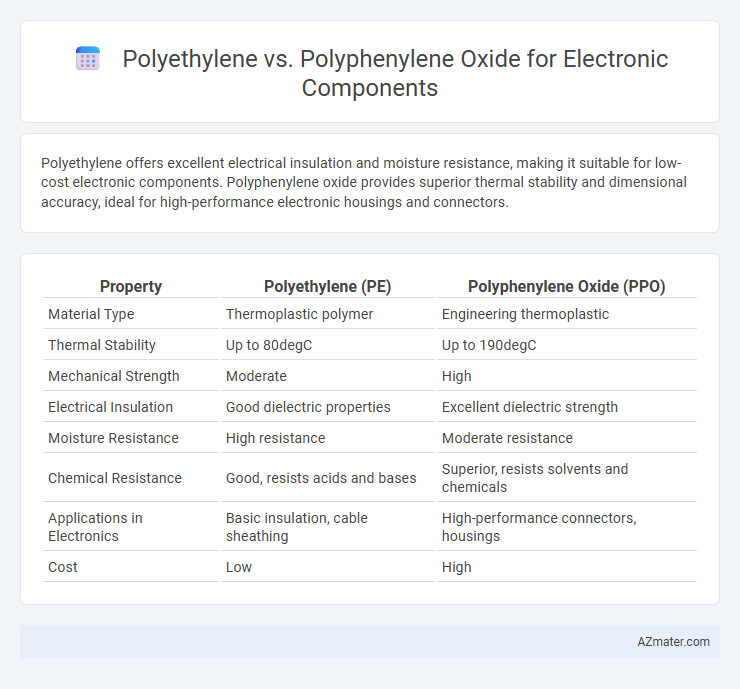Polyethylene offers excellent electrical insulation and moisture resistance, making it suitable for low-cost electronic components. Polyphenylene oxide provides superior thermal stability and dimensional accuracy, ideal for high-performance electronic housings and connectors.
Table of Comparison
| Property | Polyethylene (PE) | Polyphenylene Oxide (PPO) |
|---|---|---|
| Material Type | Thermoplastic polymer | Engineering thermoplastic |
| Thermal Stability | Up to 80degC | Up to 190degC |
| Mechanical Strength | Moderate | High |
| Electrical Insulation | Good dielectric properties | Excellent dielectric strength |
| Moisture Resistance | High resistance | Moderate resistance |
| Chemical Resistance | Good, resists acids and bases | Superior, resists solvents and chemicals |
| Applications in Electronics | Basic insulation, cable sheathing | High-performance connectors, housings |
| Cost | Low | High |
Introduction to Polyethylene and Polyphenylene Oxide
Polyethylene (PE) is a widely used thermoplastic polymer known for its excellent chemical resistance, electrical insulation properties, and cost-effectiveness, making it suitable for basic electronic components and wire insulation. Polyphenylene Oxide (PPO) is an amorphous engineering thermoplastic characterized by high thermal stability, dimensional stability, and superior dielectric properties, ideal for advanced electronic applications requiring high performance. The distinct molecular structures of PE and PPO directly influence their mechanical strength, thermal resistance, and electrical insulating capabilities, defining their specific roles in electronic component manufacturing.
Chemical Structure Comparison
Polyethylene consists of long chains of repeating ethylene units with a simple hydrocarbon backbone, providing non-polar characteristics and excellent electrical insulation properties. Polyphenylene oxide (PPO) features a backbone with aromatic rings linked by oxygen atoms, offering higher thermal stability and dimensional resistance due to its rigid structure and polar nature. The chemical difference between the saturated, flexible polyethylene and the rigid, aromatic PPO significantly influences their respective performance in electronic components, especially in terms of heat resistance and dielectric strength.
Mechanical Properties Overview
Polyethylene exhibits excellent impact resistance and flexibility, making it suitable for electronic components requiring durability under mechanical stress. Polyphenylene oxide offers superior dimensional stability, high tensile strength, and thermal resistance, which enhances the mechanical performance in high-temperature environments. The choice between these polymers depends on the specific mechanical demands, such as flexibility versus rigidity, in electronic component applications.
Thermal Stability and Heat Resistance
Polyphenylene oxide (PPO) exhibits superior thermal stability and heat resistance compared to polyethylene (PE), making it ideal for electronic components exposed to high temperatures. PPO maintains mechanical integrity above 150degC, while polyethylene typically deforms near 80-100degC, limiting its use in high-heat electronic environments. The enhanced thermal performance of PPO ensures reliable insulation and dimensional stability, critical for electronic device longevity and safety.
Electrical Insulation Capabilities
Polyphenylene oxide (PPO) exhibits superior electrical insulation properties compared to polyethylene, making it highly suitable for electronic components requiring high dielectric strength and thermal stability. PPO maintains consistent dielectric constant and low dissipation factor across a wide temperature range, ensuring reliable performance in demanding electrical environments. Polyethylene, while having good insulating abilities and low cost, typically offers lower thermal resistance and dielectric strength, limiting its application in high-performance electronic insulators.
Moisture Absorption and Weather Resistance
Polyphenylene oxide (PPO) exhibits significantly lower moisture absorption compared to polyethylene, making it a superior choice for electronic components exposed to humid environments. PPO also offers excellent weather resistance, maintaining dimensional stability and electrical properties under prolonged exposure to UV radiation and temperature fluctuations. In contrast, polyethylene tends to absorb more moisture and degrade faster under weather stresses, potentially compromising the performance and reliability of electronic parts.
Processing and Manufacturability
Polyethylene offers ease of processing due to its low melting point and high flow characteristics, making it suitable for injection molding electronic components with complex geometries. Polyphenylene oxide (PPO) exhibits superior thermal stability and dimensional accuracy but requires more precise temperature control during processing, often necessitating advanced extrusion or molding techniques. Manufacturing with PPO enables higher performance in electronic applications through enhanced mechanical properties and electrical insulation, albeit with increased production complexity and cost compared to polyethylene.
Cost and Availability for Electronics
Polyethylene offers a lower cost and widespread availability, making it a common choice for basic electronic component insulation and packaging. Polyphenylene oxide (PPO) provides superior thermal stability and electrical insulation but at a significantly higher price point and limited availability compared to polyethylene. Manufacturers often balance cost efficiency with performance requirements, choosing polyethylene for budget-sensitive applications and PPO when enhanced durability and heat resistance are critical.
Typical Applications in Electronic Components
Polyethylene is commonly used in electronic components for insulation purposes due to its excellent dielectric properties and flexibility in wire and cable coatings. Polyphenylene oxide (PPO) is favored for components requiring high thermal stability, dimensional stability, and flame resistance, such as connectors, semiconductor housings, and circuit boards. Typical applications of PPO include high-performance electronic connectors and structural parts where mechanical strength and thermal endurance are critical.
Choosing the Right Material for Electronic Design
Polyethylene offers excellent electrical insulation and chemical resistance, making it suitable for low-frequency electronic components, while Polyphenylene Oxide provides superior thermal stability and dimensional accuracy for high-performance applications. Selecting the right material hinges on operating temperature, mechanical stress, and dielectric requirements of the electronic design. Polyphenylene Oxide's low moisture absorption and high dielectric constant often favor circuit boards and connectors needing reliable long-term performance.

Infographic: Polyethylene vs Polyphenylene Oxide for Electronic Component
 azmater.com
azmater.com